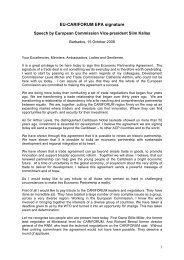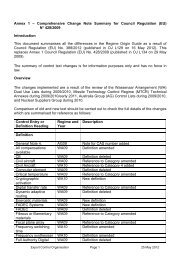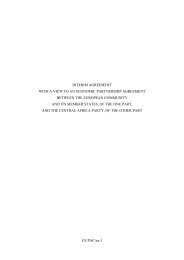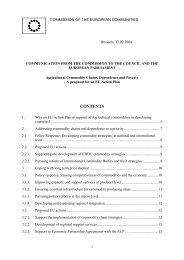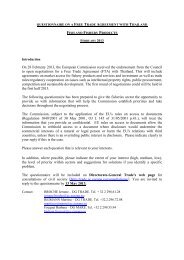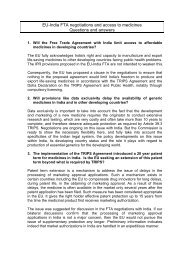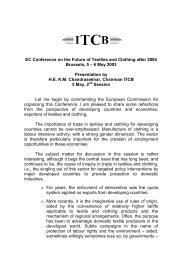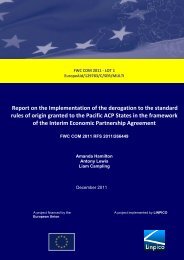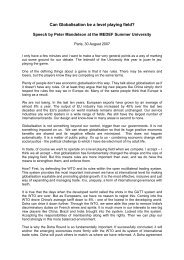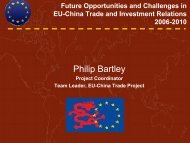Highlights of the new GSP - Trade Websites - Europa
Highlights of the new GSP - Trade Websites - Europa
Highlights of the new GSP - Trade Websites - Europa
You also want an ePaper? Increase the reach of your titles
YUMPU automatically turns print PDFs into web optimized ePapers that Google loves.
C<strong>Highlights</strong> <strong>of</strong> <strong>the</strong> <strong>new</strong> Generalised Scheme <strong>of</strong> Preferencesan Economic Partnership Agreement (EPA) or <strong>the</strong> special regime for Balkancountries).These countries will remain “eligible” but will cease to receive preferences (<strong>the</strong>y willnot be “beneficiaries”)—this nuance is important as <strong>the</strong>y could come back into<strong>the</strong> “beneficiary” list if <strong>the</strong> preferential market arrangement wasterminated. Again, use <strong>of</strong> <strong>GSP</strong> is marginal if at all by <strong>the</strong>se countries. This is whyin general <strong>the</strong>se countries will not suffer any negative impacts—in fact,some will benefit from <strong>new</strong> export opportunities as competitors cease to receivepreferences (see next paragraph).High and upper middle income countriesWhile <strong>the</strong> first set <strong>of</strong> countries above move to o<strong>the</strong>r preferences, a second set <strong>of</strong>countries lose beneficiary status because <strong>the</strong>ir needs are no longer comparable tothose <strong>of</strong> poorer developing countries. These more advanced developing countries nolonger need preferences to export; in fact, continuing to provide preferences to<strong>the</strong>m increases <strong>the</strong> competitive pressure on exports from LDCs and o<strong>the</strong>r poorcountries.Largely thanks to <strong>the</strong>ir exporting prowess, some countries have grown sosignificantly, that <strong>the</strong>ir per capita income levels are similar or higher than <strong>the</strong>incomes <strong>of</strong> certain developed countries. In terms <strong>of</strong> <strong>the</strong> World Bank per capitaincome classification, which is an objective and internationally recognisedmeasure, <strong>the</strong>y have become high or upper middle income economies. Theyclearly no longer need preferences such as <strong>the</strong> <strong>GSP</strong> to successfully tradewith <strong>the</strong> rest <strong>of</strong> <strong>the</strong> world—and <strong>the</strong>y have <strong>the</strong> resources to tackle morecomplex development problems such as income distribution, which requireadequate internal policies.Countries which have been listed in <strong>the</strong> World Bank classification as high orupper middle income economies during <strong>the</strong> most recent three years, basedon Gross National Income (GNI) per capita, continue to be eligible but wouldcease to be beneficiaries. This includes 7 high-income countries (and oneterritory) and 12 upper-middle income countries (see annex IV). Negative impactson <strong>the</strong>se countries’ exports are typically marginal (total exports fall by less than1%).Why are negative effects on <strong>the</strong>se countries so small?- The first reason is that for more advanced developing countries, exports under<strong>GSP</strong> are not necessarily a significant proportion out <strong>of</strong> total exports to <strong>the</strong> EU (<strong>the</strong>average is 8%).5
C<strong>Highlights</strong> <strong>of</strong> <strong>the</strong> <strong>new</strong> Generalised Scheme <strong>of</strong> Preferences- The second is that <strong>the</strong> margins <strong>of</strong> preference provided by <strong>the</strong> EU are relativelylow, given our already low normal tariff levels.A key point is that even marginal drops in exports by <strong>the</strong> more advanced,bigger economies, can potentially provide significant opportunities for <strong>the</strong>poorest, whose exports are very small in comparison. To give an idea <strong>of</strong> <strong>the</strong>order or magnitude, a drop <strong>of</strong> 1% in, say, Brazilian exports, is equivalent to morethan 16 times Burkina Faso's total exports to <strong>the</strong> EU.These countries remain "eligible", but are no longer "beneficiaries" <strong>of</strong> <strong>the</strong> <strong>GSP</strong>scheme. This means that in case <strong>the</strong>ir situation changes (if <strong>the</strong>y are no longerclassified as high or middle upper income) <strong>the</strong>y will become beneficiaries <strong>of</strong> <strong>the</strong>scheme again.A list <strong>of</strong> beneficiaries under <strong>the</strong> <strong>new</strong> <strong>GSP</strong> is provided under Annex V.What will change regarding “graduation” <strong>of</strong> competitive sectors?Some developing countries still have low per capita income but have extremelysuccessful export sectors for many industries. These industries (e.g., textiles,chemicals, lea<strong>the</strong>r products) are competitive worldwide at <strong>the</strong> highest level. Theyalso do not need preferences to successfully penetrate world markets. Therefore,our <strong>GSP</strong> scheme withdraws preferences to such sectors on <strong>the</strong> basis <strong>of</strong> a"graduation" mechanism.Graduation means that imports <strong>of</strong> particular groups <strong>of</strong> products and originating ina given <strong>GSP</strong> beneficiary country lose <strong>GSP</strong> preferences. Under <strong>the</strong> current scheme,graduation applies when <strong>the</strong> average imports <strong>of</strong> a section from a country exceed15% <strong>of</strong> <strong>GSP</strong> imports <strong>of</strong> <strong>the</strong> same products from all <strong>GSP</strong> beneficiary countriesduring three years (<strong>the</strong> trigger is 12.5% for textiles and clothing). It concerns<strong>the</strong>refore imports that are competitive on <strong>the</strong> EU market and so no longer need<strong>the</strong> <strong>GSP</strong> to boost <strong>the</strong>ir exports to <strong>the</strong> EU.The <strong>new</strong> <strong>GSP</strong> maintains <strong>the</strong> core principles behind graduation but correctsthree elements:• Product sections used for graduation are expanded from 21 to 32. Thisensures that graduation is more objective, as <strong>the</strong> products in <strong>the</strong> categories aremore homogenous. This avoids that graduation “overshoots”, removing preferencesfor some products which are not competitive simply because <strong>the</strong>y are in a sectionwhich includes o<strong>the</strong>r very competitive products from a different industry.• Graduation thresholds increase from 15 % to 17.5 % (and from 12.5% to14.5% for textiles. As <strong>the</strong> number <strong>of</strong> beneficiaries drop, graduation will happensooner. This is an intended effect, as our current mechanism “undershoots”, failing6
C<strong>Highlights</strong> <strong>of</strong> <strong>the</strong> <strong>new</strong> Generalised Scheme <strong>of</strong> Preferencesto identify many sectors which are competitive and thus need no preferences.However, an increase in <strong>the</strong> thresholds was necessary to keep this increase ingraduation to <strong>the</strong> minimum level necessary.• Graduation no longer applies to <strong>GSP</strong>+ countries. Like EBA countries, <strong>GSP</strong>+countries are vulnerable and display a non-diversified export base. Given thatgraduation has never applied to EBA, it was only fair to treat <strong>GSP</strong>+ countries in <strong>the</strong>same fashion. This should also make <strong>GSP</strong>+ more attractive to potential applicants(see below).On <strong>the</strong> whole, revamped graduation is expected to remove preferences from sectorsthat no longer need <strong>the</strong>m—and provide opportunity to those most in need <strong>of</strong> ourhelp.A carefully selected product expansion and increase <strong>of</strong> preferencemarginsThe <strong>new</strong> <strong>GSP</strong> incorporates a wider though limited expansion in products andpreference margins:-15 <strong>new</strong> tariff lines are added to <strong>GSP</strong> as “non-sensitive” (duty-free access);-4 tariff lines under <strong>GSP</strong> which were “sensitive” turn to “non-sensitive” (duty-freeaccess);-4 <strong>new</strong> tariff lines are added to <strong>GSP</strong>+ (duty-free access).These have been carefully selected.Why such a careful selection, leading to a relatively modest number <strong>of</strong> lines? Thereason is that <strong>the</strong> poorest (LDCs) already have duty free, quota free access for allproducts. This means that <strong>the</strong>y have an advantage for those products—<strong>the</strong>y canexport <strong>the</strong>m without duty while o<strong>the</strong>r developing countries have to pay duties.Increasing <strong>the</strong> products or preferences which enjoy <strong>GSP</strong> will <strong>the</strong>n make LDC exportsrelatively less attractive. This would set <strong>the</strong> poorest back, ra<strong>the</strong>r than help <strong>the</strong>m.This discussion underlines a general point: products from developing countriesare competing amongst each o<strong>the</strong>r in <strong>the</strong> single market, and preferences<strong>of</strong>ten determine which country can sell products and which doesn’t.This whole question should be seen in context. In fact, product coverage under <strong>GSP</strong>is already very high: 66% <strong>of</strong> tariff lines. If we add 25% <strong>of</strong> o<strong>the</strong>r lines which arealready at 0% normal duty, only 9% tariff lines (mostly agricultural products)are today outside <strong>GSP</strong>. The room for expansion is thus very limited—underlining<strong>the</strong> generosity <strong>of</strong> <strong>the</strong> scheme.The EU’s decision has thus focussed on tariff lines (mainly raw materials, seeAnnex VI for details) which would expand <strong>the</strong> opportunities to export <strong>of</strong> <strong>GSP</strong> and<strong>GSP</strong>+ beneficiaries, but would minimise <strong>the</strong> negative impact on LDCs.7
C<strong>Highlights</strong> <strong>of</strong> <strong>the</strong> <strong>new</strong> Generalised Scheme <strong>of</strong> PreferencesWhat happens to <strong>GSP</strong>+?The EU has <strong>the</strong> objective to fur<strong>the</strong>r promote core human and labour rights, andprinciples <strong>of</strong> sustainable development and good governance. To achieve <strong>the</strong>se aims,<strong>the</strong> EU will provide for more incentives for countries to join <strong>the</strong> <strong>GSP</strong>+ scheme,while at <strong>the</strong> same time enhancing its monitoring to ensure those rights andprinciples are respected.The <strong>new</strong> <strong>GSP</strong> provides powerful incentives to join <strong>GSP</strong>+ and to implement <strong>the</strong>27 core conventions:1. There will be less competition from more advanced developing economies andsectors which lose preferences.2. <strong>GSP</strong>+ countries will no longer be “graduated” by sections.3. The so-called “vulnerability criterion” (one <strong>of</strong> two economic conditions acountry needs to fulfil in order to be eligible for <strong>GSP</strong>+) is relaxed (increased from1% to 2%) so more countries can apply. Pakistan, <strong>the</strong> Philippines and Ukrai<strong>new</strong>ould thus become eligible.4. Applications will be accepted at any time—not every 1.5 years, as now.5. The number <strong>of</strong> core conventions has not been expanded, allowing countries arealistic chance to focus on <strong>the</strong> essentials.While more incentives are introduced, <strong>the</strong> <strong>new</strong> <strong>GSP</strong> reinforces <strong>the</strong> mechanismsto track <strong>the</strong> implementation <strong>of</strong> conventions by <strong>GSP</strong>+ countries. The mainchanges are as follows:1. Countries should fully cooperate with international monitoring bodies, withoutreservations.2. Monitoring will be more frequent (every 2 instead <strong>of</strong> 3 years) and with scrutinynot only by Council, but also by <strong>the</strong> European Parliament.3. Withdrawal mechanisms will be more objective. To complement <strong>the</strong> reports <strong>of</strong>international monitoring bodies, <strong>the</strong> EU may use o<strong>the</strong>r sources <strong>of</strong> accurateinformation. Also, <strong>the</strong> burden <strong>of</strong> pro<strong>of</strong> will be reversed: when evidence points toproblems with implementation, it will be up to <strong>the</strong> country to show a positiverecord.All countries which wish to enter <strong>the</strong> <strong>new</strong> <strong>GSP</strong>+ (including current <strong>GSP</strong>+beneficiaries) must make a formal application showing that <strong>the</strong> requirements <strong>of</strong> <strong>the</strong><strong>new</strong> regulation are met.8
C<strong>Highlights</strong> <strong>of</strong> <strong>the</strong> <strong>new</strong> Generalised Scheme <strong>of</strong> PreferencesWhat happens to EBA?The Everything But Arms arrangement already is an open-ended scheme and willnot change. Least Developed Countries continue to benefit from duty-free, quotafreeaccess to <strong>the</strong> European market for all products – except for arms andammunition. LDCs will also continue to benefit from <strong>the</strong> recently amended, morefavourable, <strong>GSP</strong> Rules <strong>of</strong> Origin.Under <strong>the</strong> <strong>new</strong> <strong>GSP</strong>, <strong>the</strong> effectiveness <strong>of</strong> <strong>the</strong> EBA scheme will bestreng<strong>the</strong>ned. Reducing <strong>the</strong> <strong>GSP</strong> to fewer beneficiaries, and increasing graduationwill reduce competitive pressure and make <strong>the</strong> preferences for LDCs moremeaningful—providing much more opportunity to export.Enhancing stability and predictabilityImporters and exporters need stability and predictability to actually use <strong>GSP</strong>preferences. These have been reinforced by <strong>the</strong> <strong>new</strong> <strong>GSP</strong>, in several ways:1. The scheme will no longer end every three years, as it is <strong>the</strong> case now. Ra<strong>the</strong>r,it will last 10 years.2. There will be transition periods <strong>of</strong> at least one year for changes in <strong>the</strong>original set <strong>of</strong> beneficiaries list (listed in annex V).3. Removals from <strong>the</strong> beneficiary lists will happen only if countries are listed ashigh or upper-middle income 3 years in a row.4. There are many procedures (temporary withdrawals, safeguards…) which affectoperators—yet <strong>the</strong> current regulation is <strong>of</strong>ten silent about how <strong>the</strong>se work and howoperators can defend <strong>the</strong>ir rights. The <strong>new</strong> <strong>GSP</strong> has made all <strong>of</strong> <strong>the</strong>se moredetailed and transparent.5. The <strong>new</strong> preferences will apply as <strong>of</strong> 1 January 2014—but <strong>the</strong> legal texts andrules <strong>of</strong> <strong>the</strong> <strong>new</strong> <strong>GSP</strong> have been published more than one year in advance. Thisprovides ample time for economic operators to adapt.O<strong>the</strong>r changesThe <strong>new</strong> <strong>GSP</strong> also introduces balanced improvements to <strong>the</strong> conditions forwithdrawal from <strong>the</strong> whole <strong>GSP</strong> scheme – notably in making explicit that unfairtrading practices include those affecting <strong>the</strong> supply on raw materials.Procedures that trigger <strong>the</strong> general safeguard clause have also been clarified, andspecial safeguards have been expanded to cover all textiles and ethanol.9
C<strong>Highlights</strong> <strong>of</strong> <strong>the</strong> <strong>new</strong> Generalised Scheme <strong>of</strong> PreferencesInstitutional adaptationsThe <strong>new</strong> institutional framework <strong>of</strong> <strong>the</strong> Treaty <strong>of</strong> Lisbon, with <strong>the</strong> enhanced role <strong>of</strong><strong>the</strong> European Parliament in trade policy, is reflected in <strong>the</strong> <strong>new</strong> <strong>GSP</strong>. The <strong>GSP</strong> is adynamic tool, allowing countries to potentially come in and out <strong>of</strong> <strong>the</strong> beneficiarylists. This implies that <strong>the</strong> different thresholds foreseen in <strong>the</strong> regulation which arelinked to <strong>the</strong> beneficiary pool (graduation, vulnerability), as well as <strong>the</strong> differentlists <strong>of</strong> beneficiaries, will have to be amended swiftly. In particular <strong>the</strong> text <strong>of</strong> <strong>the</strong><strong>new</strong> <strong>GSP</strong> foresees that all <strong>the</strong>se elements, which have been included in differentannexes, can be amended by <strong>the</strong> Commission via delegated acts and not via <strong>the</strong>ordinary legislative procedure which would take much longer.An overview <strong>of</strong> <strong>the</strong> different institutional provisions is provided in Annex VII.So what happens next?The fact that <strong>the</strong> <strong>new</strong> preferences will apply only on 1 January 2014, i.e., morethan one year after publication <strong>of</strong> <strong>the</strong> <strong>new</strong> <strong>GSP</strong>, provides ample time for operatorsto adapt. Until <strong>the</strong>n, <strong>the</strong> current preferences under Council Regulation (EC) No.732/2008, as extended by Regulation (EU) No 512/2011 <strong>of</strong> <strong>the</strong> EuropeanParliament and <strong>of</strong> <strong>the</strong> Council will, apply.The EU will publish in 2013 legal acts covering amongst o<strong>the</strong>rs <strong>the</strong> followingaspects:-procedures regarding <strong>GSP</strong>+ entry, withdrawals and safeguards;-list <strong>of</strong> graduated sectors;-adjustments to <strong>the</strong> <strong>GSP</strong> beneficiary list due to changes in World Bankclassification or provisional application <strong>of</strong> market access arrangements such asfree trade agreements.Please see our website for fur<strong>the</strong>r information http://ec.europa.eu/trade/wideragenda/development/generalised-system-<strong>of</strong>-preferences10
C<strong>Highlights</strong> <strong>of</strong> <strong>the</strong> <strong>new</strong> Generalised Scheme <strong>of</strong> PreferencesANNEX 1SALIENT FEATURES OF THE CURRENT EU <strong>GSP</strong> SCHEME[This information, <strong>the</strong> data and tables referred <strong>the</strong>rein can be fur<strong>the</strong>r consulted in <strong>the</strong>Impact Assessment to <strong>the</strong> Commission's proposal for <strong>the</strong> <strong>new</strong> <strong>GSP</strong> scheme under <strong>the</strong>followinglink:http://ec.europa.eu/governance/impact/ia_carried_out/docs/ia_2011/sec_2011_0536_en.pdf]IntroductionThe Generalised Scheme <strong>of</strong> Preferences (hereinafter, “<strong>the</strong> scheme”) is born out <strong>of</strong>three factors.• First, <strong>the</strong>re is wide agreement that international trade is essential fordevelopment, as it can generate significant revenue and economic activity.• Second, certain countries face difficulties to integrate fully into <strong>the</strong> internationaltrading system, and require preferences to partake in <strong>the</strong> benefits <strong>of</strong>international trade.• Third, development will only be sustainable in <strong>the</strong> long run if an economy canalso rely on industrial production ra<strong>the</strong>r than primarily on commodities—in o<strong>the</strong>rwords if it is sufficiently diversified. Preferences should thus foster exports <strong>of</strong>industrial products.Development and poverty reduction are complex goals, which necessitate myriadbuilding blocks to be realised. The scheme is one <strong>of</strong> those many blocks. While, on itsown, <strong>the</strong> scheme will not reduce poverty, it can help developing countries boostexports and develop <strong>new</strong> industries—a factor which, given an adequate political andeconomic context, can contribute significantly towards development and povertyreduction. This explains why <strong>the</strong> EU was <strong>the</strong> pioneer in <strong>the</strong> introduction <strong>of</strong> a scheme in1971, and why it has remained an important policy tool, whose objective is <strong>the</strong>expansion <strong>of</strong> exports to <strong>the</strong> EU by those countries in accordance with <strong>the</strong>ir needs.In a changing world, <strong>the</strong> EU’s scheme has had to adapt. The last decade has seen amove towards greater differentiation amongst beneficiary countries in terms <strong>of</strong>development, trade and financial needs. To reflect that, given <strong>the</strong>ir differentcircumstances, <strong>the</strong>y require also different patterns <strong>of</strong> preferences. As a result, LeastDeveloped Countries (LDCs) have been provided full duty free, quota free access to<strong>the</strong> EU (Everything But Arms initiative, hereinafter “EBA”).Also, <strong>the</strong> scheme has taken up a <strong>new</strong> role: to provide incentives to those countriescommitted to promote sustainable development and good governance (hereinafter,“<strong>GSP</strong>+”) via additional preferences. This objective is intended to complement <strong>the</strong>overall goal to help those most in need to boost exports.11
C<strong>Highlights</strong> <strong>of</strong> <strong>the</strong> <strong>new</strong> Generalised Scheme <strong>of</strong> PreferencesToday’s scheme is thus a three-tier system, with significant preferences for 111 1general beneficiaries (hereinafter, “<strong>GSP</strong>”), enhanced preferences for 15 <strong>GSP</strong>+countries, and full preferences for 50 EBA countries 2 . For a list <strong>of</strong> beneficiary countriesand <strong>the</strong>ir exports see Table 1-1 and Table 1-2 on page 8 to 15 <strong>of</strong> <strong>the</strong> ImpactAssessment document Vol. II(http://ec.europa.eu/governance/impact/ia_carried_out/docs/ia_2011/sec_2011_0536_en.pdf) Preferential imports per product category are analysed in Table 1-3 p.16. <strong>of</strong><strong>the</strong> same document.1. The general arrangementBeneficiariesThere are 111 beneficiaries <strong>of</strong> <strong>the</strong> general arrangement. Beneficiaries are establishedby applying two “negative” principles:- High income countries as classified by <strong>the</strong> World Bank are not eligible—unless <strong>the</strong>ireconomies are not sufficiently diversified. For this purpose, an economy is notsufficiently diversified if its exports to <strong>the</strong> EU <strong>of</strong> <strong>the</strong> five categories with <strong>the</strong> highestexport values are more than 75% <strong>of</strong> its total exports to <strong>the</strong> EU.- FTA partners are not eligible, if <strong>the</strong> level <strong>of</strong> preferential access provided by <strong>the</strong>iragreement is <strong>the</strong> same as that <strong>of</strong>fered by <strong>GSP</strong>.Due to historical reasons, Overseas Countries and Territories <strong>of</strong> <strong>the</strong> EU and certainoverseas territories <strong>of</strong> o<strong>the</strong>r high income countries have been included asbeneficiaries.Ex-USSR economies were also included with a view to facilitate <strong>the</strong>ir transition to amarket system.Product coverageThe general arrangement covers over 6200 tariff lines out <strong>of</strong> a total <strong>of</strong> approximately7100 tariff lines with non-zero tariffs. Roughly 2300 lines are not covered by <strong>the</strong>scheme as standard tariffs (so-called “most favoured nation” or MFN) are already at 0.Products are split into non-sensitive and sensitive categories:− Non-sensitive products enjoy duty-free access, and represent about 2400 lines;− Sensitive products (a mixture <strong>of</strong> agricultural, textile, clothing, apparel, carpetsand footwear items) benefit from tariff reductions (typically 3.5 percentagepoints on ad valorem duties) compared to <strong>the</strong> standard most favoured nationtariff. These represent about 3800 lines.<strong>Trade</strong> involvedIn 2009, just under €60 billion imports received preferences — €48 billion for countriesunder <strong>the</strong> general arrangement.1 Belarus is temporarily suspended, see below.2 Myanmar is temporarily suspended, see below.12
C<strong>Highlights</strong> <strong>of</strong> <strong>the</strong> <strong>new</strong> Generalised Scheme <strong>of</strong> PreferencesSome terminologyThere are three different terms to describe imports under <strong>the</strong> scheme. The first is"covered" imports. These are those which are <strong>the</strong>oretically able to obtain preferences.But some products are graduated from <strong>the</strong> scheme or preferences are temporarilywithdrawn (see below), so certain goods from certain beneficiary countries will not beeligible for preferences. If excluded products are subtracted from <strong>the</strong> "covered"imports, "eligible" imports are obtained. Finally, importers may not always choose touse <strong>the</strong> preferences at hand. "Preferential" imports are those <strong>the</strong> goods where EUcustoms actually accorded preferences.2. <strong>GSP</strong>+ arrangementThe philosophy <strong>of</strong> <strong>GSP</strong>+ is that <strong>of</strong> an incentive based mechanism, as opposed to a toolbased on sanctions. It fosters <strong>the</strong> achievement <strong>of</strong> its goals by <strong>of</strong>fering <strong>the</strong> “carrot” <strong>of</strong>preferences, which it provides when <strong>the</strong> relevant conventions are ratified andeffectively implemented. Thereafter, preferences are used as a lever to ensure thatimplementation (i) does not deteriorate and (ii) improves over time. A regular dialoguewith beneficiaries provides <strong>the</strong> necessary follow-up, which includes temporarywithdrawal mechanisms. This approach <strong>of</strong> progressive improvement is considered <strong>the</strong>most appropriate given that <strong>the</strong> changes that need to take place to fully implementconventions are <strong>of</strong> a complex, structural nature and involve high economic costs.Thus, <strong>the</strong>y will not happen overnight, and need to be accompanied <strong>of</strong> over longerperiods.“Effective implementation” and entry into <strong>GSP</strong>+Depending on its application, “effective implementation” criterion for entry into <strong>GSP</strong>+could be contrary to <strong>the</strong> incentive-based essence <strong>of</strong> this tool. An extremeinterpretation <strong>of</strong> <strong>the</strong> term would imply that countries would have to attain animpeccable standard <strong>of</strong> implementation before receiving preferences. This would meanthat <strong>the</strong> country’s stakeholders would have to bear <strong>the</strong> significant costs <strong>of</strong>implementation for a number <strong>of</strong> years before such a high standard could be achieved.In practice, this would erode <strong>the</strong> political support necessary for <strong>the</strong> implementation <strong>of</strong><strong>the</strong> core conventions—a self-defeating approach.Instead, <strong>the</strong> EU’s practice regarding entry has been to place emphasis on ratification <strong>of</strong>conventions and on a clear undertaking by countries to ensure effectiveimplementation, ra<strong>the</strong>r than on impeccable implementation from <strong>the</strong> outset.Preferences create incentives within <strong>the</strong> country to support effective implementation,as stakeholders stand to lose significantly from <strong>the</strong> withdrawal <strong>of</strong> preferences if <strong>the</strong>necessary progress is not achieved.BeneficiariesThe <strong>GSP</strong>+, applying until 31 December 2011 currently covers 15 beneficiaries:Armenia, Azerbaijan, Bolivia, Colombia, Costa Rica, Ecuador, El Salvador, Georgia,Guatemala, Honduras, Mongolia, Nicaragua, Peru, Paraguay and Panama (Sri Lankahas been temporarily withdrawn—see below).13
C<strong>Highlights</strong> <strong>of</strong> <strong>the</strong> <strong>new</strong> Generalised Scheme <strong>of</strong> PreferencesIn order to qualify for <strong>GSP</strong>+, countries must meet <strong>the</strong> following criteria:(1) must have ratified and effectively implemented 27 specified internationalconventions in <strong>the</strong> fields <strong>of</strong> core human and labour right, <strong>the</strong> environment and goodgovernance.(2) must give an undertaking to maintain <strong>the</strong> ratification <strong>of</strong> <strong>the</strong> conventions and <strong>the</strong>irimplementing legislation and measures, and accept regular monitoring and review <strong>of</strong><strong>the</strong> implementation record in accordance with <strong>the</strong> implementation provisions <strong>of</strong> <strong>the</strong>relevant conventions;(3) are considered 'vulnerable 3 .' A vulnerable country means a country:• which is not classified by <strong>the</strong> World Bank as a high income country during threeconsecutive years;• and whose exports to <strong>the</strong> EU are heavily concentrated in a few products (<strong>the</strong> 5largest sections <strong>of</strong> <strong>GSP</strong>-covered imports into <strong>the</strong> EU represent more than 75%in value <strong>of</strong> <strong>the</strong>ir total <strong>GSP</strong> covered exports);• and with a low level <strong>of</strong> exports to <strong>the</strong> EU (it represents less than 1% in value <strong>of</strong>total <strong>GSP</strong> covered imports).The rationale for <strong>the</strong> vulnerability criteria is as follows. In 2004, <strong>the</strong> <strong>GSP</strong> Regulationwas simplified from five arrangements to three: standard <strong>GSP</strong>, EBA and <strong>GSP</strong>+ in amanner that responds positively to special development, financial and trade needs inconsistency with <strong>the</strong> Enabling Clause. EBA (see below) is aimed at <strong>the</strong> LDCs,developmentally <strong>the</strong> most in need and who are accorded <strong>the</strong> most generouspreferences under <strong>the</strong> scheme; <strong>GSP</strong>+, <strong>of</strong>fers preferences over and above <strong>the</strong> standard<strong>GSP</strong> to a subset <strong>of</strong> beneficiary countries. These countries, though not LDCs, tend to besmall and relatively poor economies with a narrow tax base - particularly those with ahigh export concentration on a narrow range <strong>of</strong> products and <strong>the</strong>refore on a steep path<strong>of</strong> development. However, because <strong>of</strong> <strong>the</strong>ir relative economic advantage over LDCs,<strong>the</strong>y are in a better position to dedicate resources to sustainable development andtake on relevant international commitments. Vulnerability criteria reflect this.Entry is possible once every 18 months.Product coverage<strong>GSP</strong>+ has essentially <strong>the</strong> same coverage as <strong>GSP</strong>, covering roughly 70 more lines than<strong>the</strong> general arrangement. The main advantage over <strong>GSP</strong> is that <strong>GSP</strong>+ gives improvedtreatment by <strong>of</strong>fering additional, mostly duty-free preferences also for some sensitiveproducts.<strong>Trade</strong> involvedIn 2009, just over €5 billion imports were made by countries with <strong>GSP</strong>+ benefits.3. Everything but Arms (EBA)The EBA gives LDCs 4 , as defined by <strong>the</strong> UN, duty free and quota-free access to <strong>the</strong> EUfor <strong>the</strong> over 7000 tariff lines (all EU non-0 tariff lines with <strong>the</strong> exception <strong>of</strong> arms and3 For a list <strong>of</strong> all countries deemed vulnerable see <strong>the</strong> impact assessment document.14
C<strong>Highlights</strong> <strong>of</strong> <strong>the</strong> <strong>new</strong> Generalised Scheme <strong>of</strong> Preferencesarmaments). In 2009, just over €6 billion imports were made by countries with EBAbenefits.4. The graduation mechanism for <strong>GSP</strong> and <strong>GSP</strong>+ 5Graduation means that imports <strong>of</strong> particular groups <strong>of</strong> products (listed as one sectionin <strong>the</strong> EU Customs Tariff see Table 1-5, p.18 <strong>of</strong> <strong>the</strong> Impact Assessment document Vol.II(http://ec.europa.eu/governance/impact/ia_carried_out/docs/ia_2011/sec_2011_0536_en.pdf) and originating in a given beneficiary country lose <strong>GSP</strong> and <strong>GSP</strong>+preferences.Which product groups? The importance <strong>of</strong> defining sections adequatelyGraduation will have different results depending on how product groups are defined.One option is to graduate by each <strong>of</strong> <strong>the</strong> thousands <strong>of</strong> lines <strong>of</strong> <strong>the</strong> Customs Tariff (assome countries like <strong>the</strong> US have done). This has <strong>the</strong> benefit <strong>of</strong> being highly targeted,but will <strong>of</strong>fer less predictability to economic operators (imports <strong>of</strong> individual tariff linesare more likely to fluctuate than broader categories, and thus to be graduated and degraduated).Managing a system <strong>of</strong> thousands <strong>of</strong> lines is administratively morecomplex.Ano<strong>the</strong>r option is to define broader categories, which has <strong>the</strong> benefit <strong>of</strong> being morestable for operators (graduation and de-graduation will not occur as <strong>of</strong>ten), but risksputting heterogeneous products in <strong>the</strong> same basket (making <strong>the</strong> system lessmeaningful). Administration is also simpler.Graduation applies when <strong>the</strong> average imports <strong>of</strong> a section from a country exceed 15%<strong>of</strong> covered imports <strong>of</strong> <strong>the</strong> same products from all beneficiary countries during threeyears (<strong>the</strong> trigger is 12.5% for textiles and clothing). This is a proxy for those countrysectorcombinations which are sufficiently competitive and so no longer need <strong>the</strong>scheme to boost <strong>the</strong>ir exports to <strong>the</strong> EU.Graduation takes <strong>the</strong> pool <strong>of</strong> beneficiaries ra<strong>the</strong>r than total EU imports as basis due totwo empirical realities. First, <strong>the</strong> share <strong>of</strong> imports covered by <strong>the</strong> scheme as aproportion <strong>of</strong> total EU imports, per product category, is significant. Therefore, 15% (or12.5%) <strong>of</strong> covered imports will be significant also in terms <strong>of</strong> total EU imports.Second, <strong>the</strong>re is large competition amongst <strong>the</strong> three categories <strong>of</strong> beneficiaries so itis logical to have a comparative tool within this beneficiary pool to better targetpreferences to <strong>the</strong> most needy.It should be noted that if a specific group <strong>of</strong> products accounts for more than 50% <strong>of</strong>total <strong>GSP</strong>-covered exports, <strong>the</strong> group can not be graduated. The reason is that forsuch extreme cases <strong>of</strong> non-diversification, graduation could disrupt <strong>the</strong> main pillar <strong>of</strong><strong>the</strong> economy, with damaging systematic effects.Out <strong>of</strong> a total <strong>of</strong> over 2400 country-product group combinations which exist, 20 (lessthan 1%) have been graduated. Thirteen <strong>of</strong> <strong>the</strong>se involve China, with <strong>the</strong> rest splitamongst 6 o<strong>the</strong>r countries (Brazil with 2, and India, Indonesia, Malaysia, Thailand andVietnam, with one product category each).4 In addition, countries which cease to be LDCs have a three year transition period where <strong>the</strong>ycontinue to enjoy EBA treatment. At <strong>the</strong> moment, this applies to Cape Verde and Maldives.5 EBA countries cannot be graduated.15
C<strong>Highlights</strong> <strong>of</strong> <strong>the</strong> <strong>new</strong> Generalised Scheme <strong>of</strong> PreferencesAs <strong>of</strong> 1 January 2009, <strong>GSP</strong> preferences have been re-established (de-graduation) forsix countries in <strong>the</strong> following product groups:• Algeria, Section 5 (Minerals products);• India, Section 14 (Jewellery, pearls, precious metals and stones);• Indonesia, Section 9 (Wood and articles <strong>of</strong> wood);• Russia, Section 6 (Products <strong>of</strong> <strong>the</strong> chemical or allied industries) and Section 15(Base metals);• South Africa, Section 17 (Transport equipment);• Thailand, Section 17 (Transport equipment).5. Temporary withdrawalAny <strong>of</strong> <strong>the</strong> <strong>GSP</strong> arrangements may be temporarily withdrawn for serious andsystematic violations <strong>of</strong> core principles laid down in core human and labour rightsconventions and on a number <strong>of</strong> o<strong>the</strong>r grounds such as unfair trading practices andserious shortcomings in customs controls.In addition, <strong>GSP</strong>+ benefits may be temporarily withdrawn if <strong>the</strong> national legislation <strong>of</strong>a <strong>GSP</strong>+ beneficiary country no longer incorporates <strong>the</strong> relevant conventions or if thatlegislation is not effectively implemented - in o<strong>the</strong>r words if <strong>the</strong> underlying balance in<strong>GSP</strong>+ between additional trade preferences in <strong>the</strong> EU market and beneficiaries'acceptance and implementation <strong>of</strong> international sustainable development and goodgovernance rules and standards is no longer properly respected. In this regard, <strong>the</strong>Commission monitors <strong>the</strong> situation in beneficiary countries on an ongoing basisprimarily by drawing on material available from <strong>the</strong> relevant international monitoringbodies.The investigation mechanism 6The Commission informs <strong>the</strong> Council if information from <strong>the</strong> competent internationalmonitoring bodies (such as UN and ILO) indicates that <strong>the</strong>re has been a diversion, by abeneficiary country, from <strong>the</strong> effective implementation <strong>of</strong> any <strong>of</strong> conventions. In suchcases, and following consultation with EU Member States in <strong>the</strong> <strong>GSP</strong> Committee, <strong>the</strong>Commission decides to conduct an investigation to clarify <strong>the</strong> situation. In cases where<strong>the</strong> Commission following its investigation considers that temporary withdrawal <strong>of</strong>trade preferences would be necessary, it makes an appropriate proposal to this effectto <strong>the</strong> Council.Investigation is a technical tool to ga<strong>the</strong>r <strong>the</strong> facts necessary to take a decision. Ascompared with o<strong>the</strong>r similar technical instruments <strong>of</strong> EU trade law (e.g., tradedefence), <strong>the</strong> scheme does not set out in sufficient details as to procedure and rights<strong>of</strong> parties involved.Two investigations have been completed in 2009 in relation to <strong>GSP</strong>+ – one in respect<strong>of</strong> El Salvador on non-incorporation <strong>of</strong> ILO core standards and ano<strong>the</strong>r in respect <strong>of</strong> SriLanka on non-effective implementation <strong>of</strong> certain human rights conventions. The mereopening <strong>of</strong> investigations can be a catalyst for change. In <strong>the</strong> case <strong>of</strong> <strong>the</strong> investigationin respect <strong>of</strong> El Salvador, in order to avoid temporary withdrawal from <strong>GSP</strong>+, <strong>the</strong>6 This followed <strong>the</strong> pre Lisbon Treaty procedures, which will be reviewed shortly.16
C<strong>Highlights</strong> <strong>of</strong> <strong>the</strong> <strong>new</strong> Generalised Scheme <strong>of</strong> Preferencescountry introduced <strong>the</strong> necessary reforms in order to remove substantial obstacles to<strong>the</strong> exercise <strong>of</strong> ILO core labour standards.WithdrawalsFor <strong>GSP</strong>, temporary withdrawal has been applied most recently in December 2006 inrespect <strong>of</strong> Belarus on <strong>the</strong> grounds <strong>of</strong> serious and systematic violations <strong>of</strong> labour rights,as determined by <strong>the</strong> ILO. Myanmar since 1997 has also had standard benefitswithdrawn on <strong>the</strong> same grounds. Preferences should be re-established as and when<strong>the</strong> situation changes in <strong>the</strong>se two countries.For <strong>GSP</strong>+, Sri Lanka’s benefits were temporarily withdrawn in 2010 due to noneffectiveimplementation <strong>of</strong> certain human rights conventions. Thus, imports from SriLanka benefit only from <strong>the</strong> standard <strong>GSP</strong> preferential treatment.The <strong>GSP</strong>+ special dialogue mechanismAs a complement and support to ongoing monitoring by ILO, UN etc, <strong>the</strong> Commissionseeks an ongoing dialogue with <strong>GSP</strong>+ beneficiary countries on any issues concerning<strong>the</strong>ir effective implementation <strong>of</strong> <strong>GSP</strong>+ related conventions. The <strong>GSP</strong>+ is a prodevelopmentinstrument and <strong>the</strong> Commission's approach has been to use it as anincentive for progress in <strong>the</strong> effective implementation <strong>of</strong> <strong>the</strong> <strong>GSP</strong>+ relevantinternational conventions, to indicate <strong>the</strong> shortcomings in <strong>the</strong> framework <strong>of</strong> dialogue,provide time for a reactions, encourage cooperation with ILO and UN and apply <strong>GSP</strong>+withdrawal only in cases <strong>of</strong> evident non-cooperation or violations <strong>of</strong> standardsconfirmed by international monitoring bodies.This regular follow-up has underlined that ratification <strong>of</strong> all conventions has beenmaintained by all <strong>GSP</strong>+ beneficiaries, and that in general <strong>the</strong>ir implementation hasprogressed. However, significant work remains for certain countries.6. SafeguardsSafeguard measures may be applied where imports from beneficiary countries causeor threaten to cause “serious difficulty” to a Union producer. Surveillance measuresare also possible for agricultural products. None <strong>of</strong> <strong>the</strong>se measures have ever beentaken in <strong>the</strong> history <strong>of</strong> <strong>the</strong> scheme.17
C<strong>Highlights</strong> <strong>of</strong> <strong>the</strong> <strong>new</strong> Generalised Scheme <strong>of</strong> PreferencesANNEX II"Overseas countries and territories (OCT's)” (33):As explained in <strong>the</strong> body <strong>of</strong> <strong>the</strong> text, <strong>the</strong>se partners already have a special marketaccess arrangement to <strong>the</strong> EU or belong to developed countries. They would no longerbe eligible.Anguilla, Ne<strong>the</strong>rlands Antilles, Antarctica, American Samoa, Aruba, Bermuda, BouvetIsland, Cocos Islands, Christmas Islands, Falkland Islands, Gibraltar, Greenland,South Georgia and South Sandwich Islands, Guam, Heard Island and McDonaldIslands, British Indian Ocean Territory, Cayman Islands, Nor<strong>the</strong>rn Mariana Islands,Montserrat, New Caledonia, Norfolk Island, French Polynesia, St Pierre and Miquelon,Pitcairn, Saint Helena, Turks and Caicos Islands, French Sou<strong>the</strong>rn Territories, Tokelau,United States Minor Outlying Islands, Virgin Islands – British, Virgin Islands- US,Wallis and Futuna, Mayotte.ANNEX IIIPartners which have ano<strong>the</strong>r market access arrangement (34):The following partners (which belong to <strong>the</strong> 176 beneficiaries <strong>of</strong> <strong>the</strong> current scheme)would no longer be in <strong>the</strong> beneficiary list:-“Euromed” (6): Algeria, Egypt, Jordan, Lebanon, Morocco, Tunisia-Cariforum (14): Belize, St. Kitts and Nevis, Bahamas, Dominican Republic, Antiguaand Barbuda, Dominica, Jamaica, Saint Lucia, Saint-Vincent and <strong>the</strong> Grenadines,Barbados , Trinidad and Tobago, Grenada, Guyana, Surinam-Economic Partnership Agreement Market Access Regulation (12): Côte d'Ivoire,Ghana, Cameroon, Kenya, Seychelles, Mauritius, Zimbabwe, Namibia, Botswana,Swaziland, Papua New Guinea , Fiji-O<strong>the</strong>r (2): Mexico, South AfricaANNEX IVHigh-income countries (7) and territory (1) according to <strong>the</strong> World BankThe following partners (which belong to <strong>the</strong> 176 beneficiaries <strong>of</strong> <strong>the</strong> current scheme)are no longer in <strong>the</strong> beneficiary list:-Countries: Saudi Arabia, Kuwait, Bahrein, Qatar, United Arab Emirates, Oman, BruneiDarussalam-Territory: MacaoUpper-middle income countries (12) according to <strong>the</strong> World Bank18
C<strong>Highlights</strong> <strong>of</strong> <strong>the</strong> <strong>new</strong> Generalised Scheme <strong>of</strong> PreferencesThe following partners (which belong to <strong>the</strong> 176 beneficiaries <strong>of</strong> <strong>the</strong> current scheme)no longer are in <strong>the</strong> beneficiary list:-Latin America (5): Argentina, Brazil, Cuba, Uruguay, Venezuela- ex-USSR (3): Bélarus, Russia , Kazakhstan-o<strong>the</strong>r (4): Gabon, Libya, Malaysia, Palau.ANNEX VList <strong>of</strong> beneficiaries under <strong>the</strong> <strong>new</strong> <strong>GSP</strong>1. EBA (49 partners): Forty-nine countries continue to receive Everything But Arms(EBA) treatment (duty free quota free access except for arms). These are LDCs (seenote below).Africa:1. Angola2. Benin3. Burkina Faso4. Burundi5. Central African Republic6. Chad7. Comoros8. Congo, Dem. Rep. <strong>of</strong> <strong>the</strong>9. Djibouti10.Equatorial Guinea11.Eritrea12.Ethiopia13.Gambia14.Guinea15.Guinea-Bissau16.Lesotho17.Liberia18.Madagascar19.Malawi20.Mali21.Mauritania22.Mozambique23.Niger24.Rwanda25.Sao Tome and Principe26.Senegal27.Sierra Leone28.Somalia29.Sudan30.Tanzania31.Togo32.Uganda33.Zambia19
C<strong>Highlights</strong> <strong>of</strong> <strong>the</strong> <strong>new</strong> Generalised Scheme <strong>of</strong> PreferencesAsia:34.Afghanistan35.Bangladesh36.Bhutan37.Cambodia38.Lao PDR39.Maldives40.Myanmar/Burma41.Nepal42.Timor-Leste43.YemenAustralia and Pacific:44.Kiribati45.Samoa46.Solomon Islands47.Tuvalu48.VanuatuCaribbean:49.HaitiNotes:Myanmar/Burma’s preferences are withdrawn since 1997 due to serious andsystematic violations <strong>of</strong> principles <strong>of</strong> core international labour conventions. TheCommission proposed in September 2012 its reinstatement into EBA. At <strong>the</strong> time <strong>of</strong>release <strong>of</strong> this document, <strong>the</strong> European Parliament and Council were considering <strong>the</strong>Commission proposal. The Maldives has ceased to be an LDC and has a transitionalperiod where it can benefit from EBA until end 2013.2. <strong>GSP</strong> beneficiaries (40): Armenia, Azerbaijan, Bolivia, China (people's Republic <strong>of</strong>),Cape Verde, Colombia, Congo (Republic <strong>of</strong>) Cook Islands, Costa Rica, Ecuador,Georgia, Guatemala, Honduras, India, Indonesia, Iran (Islamic Republic <strong>of</strong>), Iraq,Kirghizia, Marshall (islands), Micronesia (federate States <strong>of</strong>), Mongolia, Nauru,Nicaragua, Nigeria, Niue, Pakistan, Panama, Paraguay, Peru, <strong>the</strong> Philippines, ElSalvador, Sri Lanka, Syrian (Arab Republic), Tajikistan, Thailand, Tonga,Turkmenistan, <strong>the</strong> Ukraine, Uzbekistan, Vietnam.3. <strong>GSP</strong>+Initially, <strong>the</strong> <strong>GSP</strong>+ beneficiary list is empty, as all eligible countries must apply for<strong>new</strong> <strong>GSP</strong>+ benefits, including those countries which benefit from <strong>GSP</strong>+ today. All <strong>GSP</strong>beneficiaries with <strong>the</strong> exception <strong>of</strong> China, Colombia India, Indonesia, Thailand andVietnam are considered vulnerable and thus are eligible to apply for <strong>GSP</strong>+.20
C<strong>Highlights</strong> <strong>of</strong> <strong>the</strong> <strong>new</strong> Generalised Scheme <strong>of</strong> PreferencesANNEX VIProducts which have been incorporated into <strong>the</strong> <strong>new</strong> <strong>GSP</strong>; products withhigher preferences under <strong>the</strong> <strong>new</strong> <strong>GSP</strong><strong>GSP</strong>: New tariff lines benefiting from preferences as non-sensitive productsCN codeDescription280519 Alkali/alkaline-earth metals o<strong>the</strong>r than sodium & calcium280530 Rare-earth metals, scandium & yttrium, whe<strong>the</strong>r/notintermixed/interalloyed281820 Aluminium oxide (excl. artificial corundum)310221 Ammonium sulphate310240 Mixtures <strong>of</strong> ammonium nitrate with calcium carbonate/o<strong>the</strong>rinorganic non-fertilising substance310250 Sodium nitrate310260 Double salts & mixtures <strong>of</strong> calcium nitrate & ammonium nitrate320120 Wattle extract780199 Unwrought lead o<strong>the</strong>r than refined, n.e.s. in 78.01810194 Unwrought tungsten (wolfram), incl. bars & rods obt. simply bysintering810411 Unwrought magnesium, containing at least 99.8% by weight <strong>of</strong>magnesium810419 Unwrought magnesium (excl. <strong>of</strong> 8104.11)810720 Unwrought cadmium; powders810820 Unwrought titanium; powders810830 Titanium waste & scrap<strong>GSP</strong>: Tariff lines which were sensitive and will now be non-sensitiveCN codeDescription06031200 Fresh Cut Carnations And Buds, Of A Kind Suitable For Bouquets OrFor Ornamental Purposes24011060 Sun-Cured Oriental Type Tobacco, Unstemmed Or Unstripped39076020 Poly "Ethylene Terephthalate", In Primary Forms, Having A ViscosityNumber Of >= 78 Ml/G")Video Recording Or Reproducing Apparatus (Excl. Magnetic Tape-85219000 Type);Video Recording Or Reproducing Apparatus, Whe<strong>the</strong>r Or NotIncorporating A Video Tuner (Excl. Magnetic Tape-Type And VideoCamera Recorders)21
C<strong>Highlights</strong> <strong>of</strong> <strong>the</strong> <strong>new</strong> Generalised Scheme <strong>of</strong> Preferences<strong>GSP</strong>+: New tariff lines benefiting from preferencesCN codeDescription280519 Alkali/alkaline-earth metals o<strong>the</strong>r than sodium & calcium280530 Rare-earth metals, scandium & yttrium, whe<strong>the</strong>r/notintermixed/interalloyed281820 Aluminium oxide (excl. artificial corundum)780199 Unwrought lead o<strong>the</strong>r than refined, n.e.s. in 78.0122
Annex VII - <strong>GSP</strong> Regulation(amended by ordinary legislative procedure)Regulation on procedures:-application for <strong>GSP</strong>+-withdrawal/reinstatement <strong>of</strong> <strong>GSP</strong>+-withdrawal/reinstatement <strong>of</strong> <strong>GSP</strong>, <strong>GSP</strong>+, EBA- SafeguardsDecision to establish or review a list <strong>of</strong> <strong>GSP</strong> sections that aresuspended from <strong>GSP</strong> preferencesRecitalsChapter I General provisionsAnnex I List <strong>of</strong> eligible countriesChapter II <strong>GSP</strong>Annex II <strong>GSP</strong> beneficiary listAnnex V <strong>GSP</strong> product listAnnex VI Graduation thresholdsDecisions amending <strong>the</strong> AnnexesDecision to amend Annex I toadd or remove a country from<strong>the</strong> list <strong>of</strong> eligible countriesDecision to amend Annex II toadd or remove a country from <strong>the</strong>list <strong>of</strong> <strong>GSP</strong> beneficiary countriesDecision to amend Annex Vto change <strong>GSP</strong> product listDecision to initiate or terminate <strong>GSP</strong>+ temporary withdrawalprocedureDecision to amend annex III to temporary withdraw orto reinstate <strong>GSP</strong>+ preferencesDecision to amend <strong>the</strong> decision to temporary withdrawpreferencesDecision on rules for implementing <strong>the</strong> provisions onimports <strong>of</strong> sugar productsDecision to initiate or terminate <strong>GSP</strong>,<strong>GSP</strong>+ or EBA temporarywithdrawal procedure for reasons <strong>of</strong> Art19(1)Decision to temporary withdraw <strong>the</strong> preferences, prolong orterminate temporary withdrawal in <strong>the</strong> case <strong>of</strong> fraudDecision to immediately reintroduce Common Customs Tariffduties for a period <strong>of</strong> up to 12 months in <strong>the</strong> exceptionalcircumstancesDecision to reintroduce Common Customs Tariff dutiesdue to findings <strong>of</strong> safeguard investigationDecision to terminate safeguard investigationChapter III <strong>GSP</strong>+Annex III <strong>GSP</strong>+ beneficiary listAnnex VIII List <strong>of</strong> conventionsAnnex IX <strong>GSP</strong>+ product listAnnex VII Vulnerability thresholdsChapter IV EBAAnnex IV EBA beneficiary listChapter V Temporary withdrawalsDecision to amend annex II, III or IV to temporary withdraw orto reinstate <strong>GSP</strong>, <strong>GSP</strong>+ or EBA preferencesDecision to amend <strong>the</strong> decision to temporary withdrawpreferencesChapter VI SafeguardsChapter VII Common provisionFinal provisionsDecision to amend Annex VI tochange graduation thresholdsDecision to amend Annex III toadd or remove a country from <strong>the</strong>list <strong>of</strong> <strong>GSP</strong>+ beneficiary countriesDecision to amend Annex IXto change<strong>GSP</strong>+ product listDecision to amend Annex VII tochangevulnerability thresholdsDecision to amend Annex IV toadd or remove a country from<strong>the</strong> list <strong>of</strong> EBA beneficiary countriesDecision to remove preferencesin textile and agriculture sectorDecision to suspend preferences due to seriousdisturbance to EU markets, in particular to outermostiDecision to apply surveillance mechanism inagriculture23




